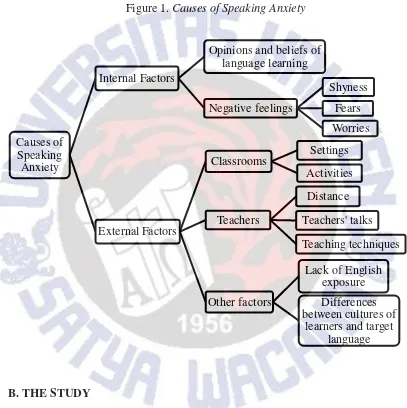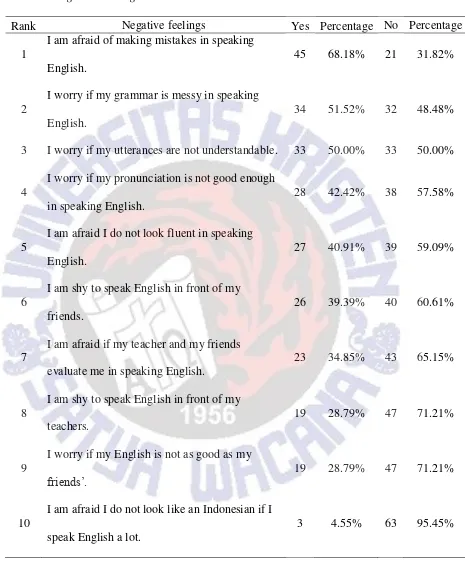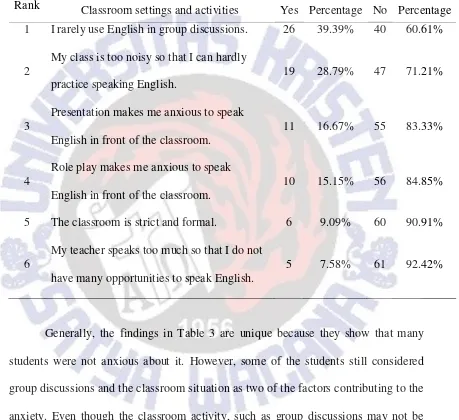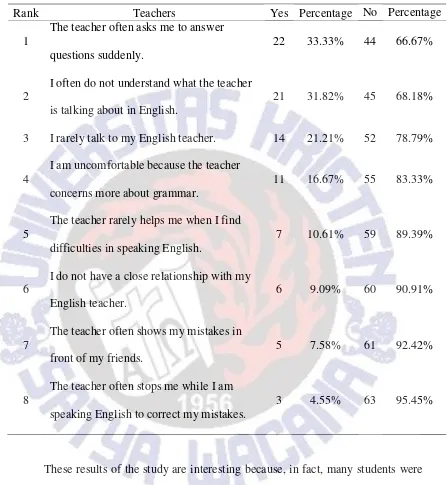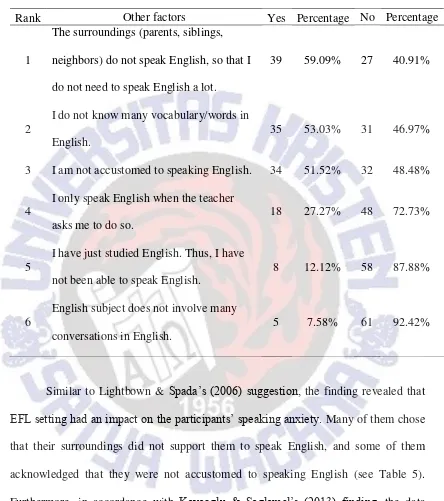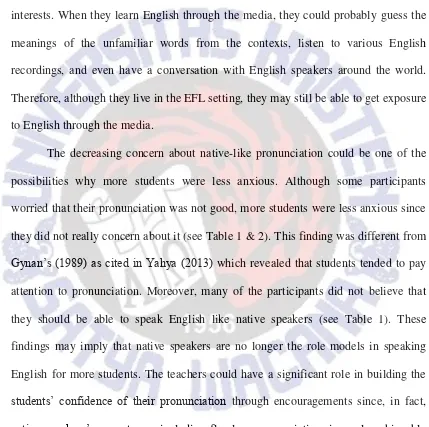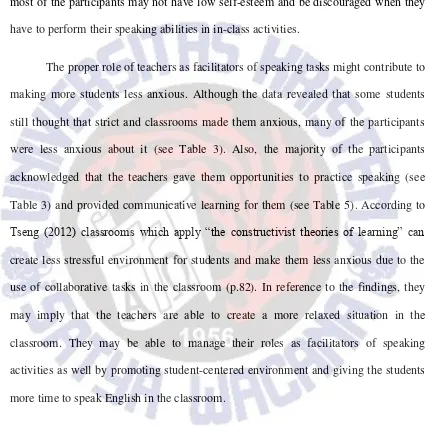A STUDY OF STUDENTS’ SPEAKING ANXIETY AT SMP
KRISTEN SATYA WACANA
THESIS
Submitted in Partial Fulfillment of the Requirements for the Degree of
Sarjana Pendidikan
Wulandari Santoso
112011108
ENGLISH LANGUAGE EDUCATION PROGRAM
FACULTY OF LANGUAGE AND LITERATURE
SATYA WACANA CHRISTIAN UNIVERSITY
SALATIGA
A STUDY OF STUDENTS’ SPEAKING ANXIETY AT SMP
KRISTEN SATYA WACANA
THESIS
Submitted in Partial Fulfillment of the Requirements for the Degree of
Sarjana Pendidikan
Wulandari Santoso
112011108
ENGLISH LANGUAGE EDUCATION PROGRAM
FACULTY OF LANGUAGE AND LITERATURE
SATYA WACANA CHRISTIAN UNIVERSITY
SALATIGA
TABLE OF CONTENT
INSIDE COVER PAGE ... i
APPROVAL PAGE ... Error! Bookmark not defined. COPYRIGHT STATEMENT ... Error! Bookmark not defined. PUBLICATION AGREEMENT DECLARATION ... iii
3. Data Collection Instrument ... 8
4. Data Collection Procedures... 9
5. Data Analysis Procedure ... 9
C. FINDINGS AND DISCUSSION ... 9
1. Opinions and Beliefs of Language Learning ... 10
2. Negative Feelings... 11
3. Classroom Settings and Activities ... 13
LIST OF FIGURE
Figure 1. Causes of Speaking Anxiety ... 7
LIST OF TABLES Table 1. Opinions and Beliefs of Language Learning ... 10
Table 2. Negative Feelings ... 12
Table 3. Classroom Settings and Activities... 14
Table 4. Teachers ... 16
A STUDY OF STUDENTS’ SPEAKING ANXIETY AT SMP
KRISTEN SATYA WACANA
Wulandari Santoso
ABSTRACT
This study aimed at investigating the causes of students‟ speaking anxiety at SMP Kristen Satya Wacana. A mixed-method was used in the study in order to present both quantitative and qualitative data. This study used a set of questionnaires distributed to sixty-six participants at SMP Kristen Satya Wacana. The participants were asked to choose the causes of their speaking anxiety offered in the questionnaire items according to their personal opinions. The questionnaire items were developed based on the literature used in this study. After that, the quantitative data were presented and then the data were described qualitatively. The results of this study revealed that the major factor contributing to the participants‟ speaking anxiety was the concern about accuracy and grammar. Interestingly, the quantitative data of this study showed that a significant number of participants were less anxious especially when dealing with classroom settings and activities, and teachers. The results of the study is expected to contribute to student teachers and language teachers in general. This study is to help them to be aware that speaking anxiety may exist among EFL student, so that they can develop their approaches in teaching speaking to minimize their students‟ anxiety and to give more exposure to English for their students.
Keywords: speaking anxiety, students
A. INTRODUCTION
it is felt by the learner” (p. 229). In other words, it is the student who can determine whether anxiety has good or bad impacts on the language learning process.
Anxiety is commonly experienced by foreign language students. Ohata (2005) highlights that a foreign language class may trigger the anxiety arousal compared to other courses. Interstingly, Tseng (2012) points out that the anxiety likely happens in speaking situations. Therefore, speaking anxiety is worth examining since it may become one of the factors which contributes to the success of students in mastering a foreign language. Randall (2007) describes that anxious students might have difficulties in concentrating, become easy to forget, and have sleep nuisance. Also, Gregersen (2005) finds out that anxious learners have difficulties to response to their errors effectively. Such anxiety makes learners “dwells on their personal deficiencies and the obstacle they encounter rather than concentrating on how to perform the task successfully” (Dornyei, 2005, p.87).They may not be able to make sufficient progress in their learning since they focus more on their weaknesses than their performance. Consequently, they tend to show a poor performance and even to give up the learning process.
I am curious to find out what makes students anxious to speak English in the classroom.
Several studies (Liu, 2007; Subasi, 2010; Kayaoglu & Saglamel, 2013) look at the anxiety of university students. Different categories, such as low English proficiency, speaking activities, a fear of negative evaluation, and competitiveness, were found to be the causes of the students‟ anxiety. However, in this study, I am intended to discuss the causes of speaking anxiety of junior high school students who are already exposed to English.
Primarily, this study aims to investigate the causes of students‟ speaking anxiety. Specifically, it attempts to find out the causes of speaking anxiety experienced by junior high school students. Also, this study is set out to answer the question: What are the causes of students‟ anxiety about speaking English at SMP Kristen Satya Wacana?
1. Anxiety
The definition of anxiety has generated various opinions among the experts. According to Rajanthran, Prakash, & Husin(2013) “Anxiety is closely connected to feelings of frustration, dissatisfaction and worry” (p. 2042). Similarly, Pappamihiel (2002) argues that an anxiety can be associated with “threats to self-efficacy and appraisals of situations as threatening” (p.331). Haskin, Smith, & Racine (2003) also note that anxiety happens when a person doubts his or her abilities to do something, and therefore it results in fear and a lack of self-esteem. Also, Dornyei (2005) has a strong belief that if students do not feel secure about themselves due to anxiety, they will unlikely improve their performance in a learning process. In short, the anxiety can be a threat to the learning process because students may feel discontent with their performance.
2. Speaking Anxiety
3. Causes of Speaking Anxiety
Some studies have revealed causes of speaking anxiety which vary from one another. Tanveer (2007) suggests that the internal factors of students may provoke anxiety, such as opinions and beliefs of language learning and the fear of losing self-identity. Likewise, Jones (2004) reveals that students are frequently afraid of making mistakes and appearing incompetent in front of their peers. Liu & Chen (2013) emphasizes that worries that their peers have a better English speaking ability and performance can contribute significantly to students‟ anxiety. Williams & Andrade (2008) notes that students usually worry about pronunciation, grammar, and comprehensible language while speaking in a foreign language. Shyness also plays a role in making students anxious (Zhiping & Paramasivan, 2013). In addition, Liu & Jackson (2008) demonstrates that fear of negative evaluation can be a factor causing the anxiety. In short, there are some internal factors provoking the anxiety to students, such as their beliefs about language learning, fears, shyness, and worries.
Some other experts tend to consider the external factors contributing to the speaking anxiety. Tanveer (2007) states that the differences between cultures of learners and target language can make learners anxious in their language learning. Lightbown & Spada (2006) argue that a lack of exposure to English in their home countries may inhibit students‟ communicative skills. EFL settings may affect their speaking competence since they may not have many opportunities to practice their communication skills. Hence, it will likely make them feel stress when it comes to speaking English in the classroom.
not effective for learners to practice speaking and promote the teacher-centered environment. Thus, students are often reluctant to speak since they probably feel insecure due to the dominance of the teacher. Also, a strict and formal classroom environment can trigger students to feel stressed when they are required to practice their speaking skills (Tseng, 2012). Furthermore, Woodrow (2006) finds the most anxiety-provoking speaking activities are oral presentations, role plays, and formal discussions. In short, the ineffective class situations and speaking activities may become possible factors generating the anxiety.
In addition, some researchers indicate that teachers can be the external sources of speaking anxiety. The improper way of teaching and their reluctance to build a relationship with their students can make students anxious in their foreign language learning (Worde, 1998). In another study, Worde (2003) adds that the way teachers correct their students‟ errors will possibly cause speaking anxiety, for instance, by correcting their speaking errors even before they finished making a response may make them frustrated. Likewise, Williams & Andrade (2008) states that the difficulty to respond to teachers‟ questions is one of the factors causing students anxious. Gregersen (2003) admits that teachers do not always eager to recognize anxious students. Therefore, they may be unwilling to get involved in speaking activities. Sato (2003) demonstrates that the primary focus on forms rather than content in the teaching can make students reluctant to practice speaking in the classroom. This may hinder their confidence in speaking since they concern more about their accuracy.
anxiety presented in the following figure. This figure is made based on the theories of the literature used in this study.
Figure 1. Causes of Speaking Anxiety
B.THE STUDY
1. Context of the Study
This study was conducted at SMP Kristen Satya Wacana, Salatiga, Central Java. This school not only provides a comprehensive learning of reading and writing, but also supports the use of communicative learning in the English lesson. Moreover, each meeting should be able to facilitate the students to practice their speaking skills through various activities and tasks. Thus, they may be able not only to comprehend, but also to perform the target language communicatively.
2. Participants
The participants of this study were sixty-six students from seven up to nine grade of SMP Kristen Satya Wacana in Salatiga, aged 13-15 years old. The consideration of choosing these participants was that they were exposed to the communicative learning environment of English at the school through a variety of speaking activities. Therefore, the speaking anxiety might be experienced by them. In choosing the participants, a random sample was used to get a representative sample so that it would facilitate every student in the school to have a chance of being involved in this study.
3. Data Collection Instrument
the second part of the questionnaires asked for the demographical information of the students such as gender, age, and the length of studying English.
4. Data Collection Procedures
Data collection took place during the second semester of the academic session 2014/2015. Before distributing the questionnaires to the students, they were informed that their names and responses to the questions would be kept confidential and not affect their grades in any way. Afterward, sixty-six students were asked to fill in the closed-ended questionnaires.
5. Data Analysis Procedure
To analyze the data, firstly the students‟ responses to the closed-ended questionnaires were classified based on Figure 1. Then, in order to present the quantitative data, the frequency and the percentage of each answer was counted using Microsoft Excel to find out the common causes contributing to their speaking anxiety. Eventually, the data was described and interpreted qualitatively according to their classification as presented in Figure 1.
C. FINDINGS AND DISCUSSION
1. Opinions and Beliefs of Language Learning
In this study, opinions and beliefs of language learning related to accuracy and grammar played an important role in contributing to the participants‟ speaking anxiety. However, the other factors were less significant in causing the anxiety. The results are presented in the following table.
Table 1. Opinions and Beliefs of Language Learning
Rank Opinions and beliefs of language learning Yes Percentage No Percentage 1 Accuracy in speaking English is important. 47 71.21% 19 28.79%
2
Grammar is one of the most important aspects of speaking English.
43 65.15% 23 34.85%
3
Pronunciation is one of the most important aspects of speaking English.
32 48.48% 34 51.52%
4 My pronunciation is weird. 27 40.91% 39 59.09% 5 Speaking English is difficult. 24 36.36% 42 63.64%
6
I should be able to speak English like native speakers.
23 34.85% 43 65.15%
7
I should not use unfamiliar words in speaking English.
9 13.64% 57 86.36%
8
Although I have worked hard, I still cannot speak English.
4 6.06% 62 93.94%
This is in line with Gregersen‟s (2003) and Tsiplakides & Keramida‟s (2009) finding
showing that students experiencing anxiety tend to attempt to produce perfect sentences and to pay attention more to grammar rather than content.
The use of KTSP curriculum which is no longer focusing on grammar but functions should be able to facilitate the students to learn English better since they can speak English without paying too much attention to the accuracy. However, this study revealed that the majority of the students still considered grammar and accuracy as important aspects of speaking English. One of the possibilities why this happened could be the impact of the previous curriculum. Putra (2014) states that most teachers do not really concern about teaching productive skills in implementing the curriculum. The participants may be accustomed to the way of teaching English with the focus on form as one of the impacts of the previous curriculum. In other words, viewing accuracy and grammar as important aspects of speaking English has possibly become the students‟ habit because they might have experienced the learning process
which focuses on the form for a certain period of time. Therefore, they tend to pay attention more to grammar although the teachers may have efforts to promote the communicative learning in the classroom. The rest of the findings in Table 1 will be discussed in the next section.
2. Negative Feelings
Table 2. Negative Feelings
Rank Negative feelings Yes Percentage No Percentage 1
I am afraid of making mistakes in speaking English.
45 68.18% 21 31.82%
2
I worry if my grammar is messy in speaking English.
34 51.52% 32 48.48%
3 I worry if my utterances are not understandable. 33 50.00% 33 50.00%
4
I worry if my pronunciation is not good enough in speaking English.
28 42.42% 38 57.58%
5
I am afraid I do not look fluent in speaking English.
I am afraid if my teacher and my friends evaluate me in speaking English.
were still some who were anxious about it. Nevertheless, similar to Jones‟s (2004) finding, many of the participants still worried if their grammar was messy. In other words, they might be afraid of making mistakes in terms of grammar. The teachers‟
concern about grammar may not be one of the possible reasons why it happens because the data (see Table 4) shows that more students did not feel that way. This could be caused by the participants‟ concern about grammar as shown in Table 1. By paying attention more to grammar, it could make the students anxious to make mistakes on it in their learning process.
Furthermore, the study revealed that a half of the participants were worried if their utterances were not understandable. This result corresponds to Yahya‟s (2013) suggestion that anxious students tend to be afraid that others do not understand what they are talking about in the second language. Horwitz, Horwitz, & Cope (1986) also states that anxiety can appear when it is hard to make ourselves understood in a foreign language. This may happen since most of the participants concern more about grammar. Additionally, this worry may be affected by the partners to whom the participants speak. If the participants feel secure and comfortable with the partners, they may not be too worried if their language is quite hard to understand. That is because they will probably feel more comfortable to repair their utterances during conversations.
3. Classroom Settings and Activities
found those factors make them anxious. The findings are presented in the following table.
Table 3. Classroom Settings and Activities
Rank Classroom settings and activities Yes Percentage No Percentage 1 I rarely use English in group discussions. 26 39.39% 40 60.61%
2
My class is too noisy so that I can hardly practice speaking English.
19 28.79% 47 71.21%
3
Presentation makes me anxious to speak English in front of the classroom.
11 16.67% 55 83.33%
4
Role play makes me anxious to speak English in front of the classroom.
10 15.15% 56 84.85%
5 The classroom is strict and formal. 6 9.09% 60 90.91%
6
My teacher speaks too much so that I do not have many opportunities to speak English.
5 7.58% 61 92.42%
think that these activities are stressful since they may not be confident enough to perform their abilities.
Although many of the participants did not feel that noisy classrooms could affect their speaking anxiety, some of them still admitted that it made them anxious. This is also in line with Sato‟s (2003) suggestion that such classrooms may not provide sufficient opportunities for students to practice speaking. The number of students in each class at Satya Wacana Junior High School which is approximately thirty students may not support them to practice speaking English effectively. One of the possible reasons could be the teachers may not be able to assist each of the students intensively by giving a more personal feedback when they are in a big classroom. The teachers‟ assistance in the classroom may be important because the students often need comprehensive feedback to improve their abilities in speaking. Additionally, since noisy classrooms might make the students difficult to practice speaking English and not support a comfortable classroom situation, they could be anxious to speak English in the classroom.
4. Teachers
Table 4. Teachers
Rank Teachers Yes Percentage No Percentage 1
The teacher often asks me to answer questions suddenly.
22 33.33% 44 66.67%
2
I often do not understand what the teacher is talking about in English.
21 31.82% 45 68.18%
3 I rarely talk to my English teacher. 14 21.21% 52 78.79%
4
I am uncomfortable because the teacher concerns more about grammar.
11 16.67% 55 83.33%
5
The teacher rarely helps me when I find difficulties in speaking English.
7 10.61% 59 89.39%
6
I do not have a close relationship with my English teacher.
6 9.09% 60 90.91%
7
The teacher often shows my mistakes in front of my friends.
5 7.58% 61 92.42%
8
The teacher often stops me while I am speaking English to correct my mistakes.
3 4.55% 63 95.45%
their mother tongue to answer questions. Pappamihiel‟s (2002) finding indicated that if the teacher allows the use of mother tongue in the classroom, it can make the students less anxious. From this finding, it can be seen that the use of mother tongue to some extent in the classroom may need to be taken into account. For some reasons, students may feel at ease when teachers permit them to use their mother tongue to some extent during the conversation with their teachers. Thus, they can reduce the anxiety when they deal with the teacher‟s questions and even other speaking
activities.
Additionally, the result of this study is in line with Kayaoglu & Saglamel‟s (2013) finding. Although many of the participants did not find difficulties in understanding the teachers‟ explanations, some were still anxious about it. One of the possibilities why this happened could be the fast pace of the teachers while speaking to the students. Moreover, the level of English proficiency may affect their understanding of teachers‟ explanations. If the teachers, for instance, use vocabulary that are not suitable with the students‟ level proficiency, they could have higher anxiety since they might have no idea how to respond to the teachers‟ explanations.
5. Other Factors
Table 5. Other Factors
Rank Other factors Yes Percentage No Percentage
1
The surroundings (parents, siblings, neighbors) do not speak English, so that I do not need to speak English a lot.
39 59.09% 27 40.91%
2
I do not know many vocabulary/words in English.
35 53.03% 31 46.97%
3 I am not accustomed to speaking English. 34 51.52% 32 48.48%
4
I only speak English when the teacher asks me to do so.
18 27.27% 48 72.73%
5
I have just studied English. Thus, I have not been able to speak English.
8 12.12% 58 87.88%
6
English subject does not involve many conversations in English.
5 7.58% 61 92.42%
reading texts (Intansari, 2013) should be able to facilitate students to encounter new vocabulary. However, according to the data, there are still students who found themselves lack of vocabulary. One of the possibilities why this happened could be the kinds of texts provided by the teachers might contain some difficult vocabulary. Thus, the students may find it difficult to comprehend the vocabulary given by the teachers. Another possible reason is that sometimes the teachers might not be able to provide adequate follow-up vocabulary activities after reading sections. Failure to do that could possibly make the students not able to gain comprehensible vocabulary input from the texts given.
6. More Students are Less Anxious
In addition, nowadays the roles of media such as movies, songs, and Internet, could be one of the possibilities why more students were less anxious. Even though the EFL setting may have a role to limit their opportunities to speak English (see Table 5), through the media they can get more exposure to English based on their interests. When they learn English through the media, they could probably guess the meanings of the unfamiliar words from the contexts, listen to various English recordings, and even have a conversation with English speakers around the world. Therefore, although they live in the EFL setting, they may still be able to get exposure to English through the media.
repertoire (Jindapitak & Teo, 2013). That could be one of the possibilities why more students did not worry if their pronunciation is not as good as native speakers.
The way the teachers gave feedback might contribute to making the majority of the participants less anxious. The data showed that a number of students still found negative evaluation from the teachers and friends make them anxious. However, different from Na‟s (2007) & Zhiping & Paramasivan‟s (2013) studies, this study revealed that more students did not anxious about negative evaluations (see Table 2 & 4). William & Andrande (2008) found that teachers had 50.61% probability to make their students anxious while in this study, they only had 28.79% (see Table 2). The distinction between these findings may happen due to the different contexts in which the studies were administered. Na (2007) argued that Chinese people concerned much about their faces. Thus, they tend to dislike negative evaluations addressed to themselves. Meanwhile, although Indonesian people may do the same thing, the school where this study was conducted may have a lower pressure learning environment in which the teachers have more effective ways of giving feedback to the students, such as appreciating the good things they have done in their performances and giving suggestions for improvements in less tense ways. Another possibility is the teachers may use effective teaching techniques to let the students practice speaking so that they can overcome their anxiety while speaking in front of their teachers and friends.
Nevertheless, different from Kitano‟s (2001) study, the majority of them were not anxious about it. This could be caused by the low sense of competition the classroom might have. In this study, the sense of competition tends to be less significant since most of the participants may not have low self-esteem and be discouraged when they have to perform their speaking abilities in in-class activities.
The proper role of teachers as facilitators of speaking tasks might contribute to making more students less anxious. Although the data revealed that some students still thought that strict and classrooms made them anxious, many of the participants were less anxious about it (see Table 3). Also, the majority of the participants acknowledged that the teachers gave them opportunities to practice speaking (see Table 3) and provided communicative learning for them (see Table 5). According to Tseng (2012) classrooms which apply “the constructivist theories of learning” can
create less stressful environment for students and make them less anxious due to the use of collaborative tasks in the classroom (p.82). In reference to the findings, they may imply that the teachers are able to create a more relaxed situation in the classroom. They may be able to manage their roles as facilitators of speaking activities as well by promoting student-centered environment and giving the students more time to speak English in the classroom.
D. CONCLUSION
less anxious, especially when dealing with classroom settings and activities, and teachers. The results of this study are not to generalize the causes of speaking anxiety experienced by learners in common since other studies may have different findings due to different contexts in terms of settings and participants.
Students should be aware of the causes of their speaking anxiety so that they may be able to use some strategies that suit them to cope with the anxiety. If they, for instance, find themselves to be anxious due to grammar, a strategy that they may use is to shift their concern to content and expand their vocabulary. Despite the fact that students are EFL learners, less anxious students can equip themselves with more exposure to English through the appropriate use of media, such as movies, songs, and Internet.
Also, teachers should take parts in overcoming their students‟ speaking anxiety in grammar. It is advisable for teachers to facilitate students to acquire grammar from texts in the text-based teaching activities and to provide vocabulary building to help them to learn new vocabulary. By doing so, it is hoped students can be more encouraged to speak English since they may be able to cope with the anxiety. In addition, teachers can use some media in teaching such as videos and songs to provide students with more exposure to English.
A further research about the causes of students‟ speaking anxiety in bilingual
ACKNOWLEDGEMENT
First of all, I want to thank God for always blessing me from the beginning of my study until the end of my thesis submission. On this occasion with great humility, I would like to thank all of those who have helped and guided me so that this thesis can be finished. I would like to thank to:
1. My mom who always gives me supports and attention during my study. 2. My supervisor, Maria Christina Eko Setyarini, M. Hum. I am thankful to
her for the assistance and advice for my thesis.
3. My examiner, Dian Toar Y. G. Sumakul, MA. I am grateful to him for encouraging me and examining my thesis.
4. My best friend, Micky who is always there to support me during my study.
REFERENCES
Biemiller, A. (2003). Vocabulary: needed if more children are to read well. Reading
Psychology, 24, 323-335. Retrieved 6 April, 2015, from
Gregersen, T. S. (2003). To err is human: A reminder to teachers of language-anxious students. Foreign language annals, 36 (1), 25-32. Retreived 8 October, 2014, from http://onlinelibrary.wiley.com/doi/10.1111/j.1944-frustration in the Spanish language classroom. Illinois, Chicago: EDUCATIONAL RESOURCES INFORMATION (ERIC). Retrieved 10 October, 2014, from http://files.eric.ed.gov/fulltext/ED474368.pdf
http://file.upi.edu/Direktori/FPBS/JUR._PEND._BAHASA_INGGRIS/19670 6091994031-DIDI_SUKYADI/07-intanbm.pdf
Jindapitak, N., & Teo,A. (2013). The Emergence of world Englishes: Implication for English language teaching. Asian Journal of Social Sciences and Humanities,
2 (2). 190-199. Retrieved 17 April, 2015, from http://www.ajssh.leena-speaking classes. Journal of History Culture and Art Research, 2 (2), 142-160. Retrieved 8 October, 2014, from
Kitano, K. (2001). Anxiety in the college Japanese language classroom. The Modern Language Journal, 85, 549-566. Retrieved 8 October, 2014, from http://www.jstor.org/discover/10.2307/1193075?uid=390376051&uid=2134& uid=3&uid=60&uid=390376061&uid=70&uid=3738224&uid=2&purchase-type=article&accessType=none&sid=21105699607231&showMyJstorPss=fal se&seq=2&showAccess=false
Lightbown, P. M., & Spada, N. (2006). How language are learned (3rd ed.). Oxford: Oxford University Press.
Liu, H. J., & Chen, T.H. (2013). Foreign language anxiety in young learners: How it relates to multiple inte lligences, learner attitudes, and perceived competence.
Journal of Language Teaching and Research, 4 (5), 932-938. Retrieved 10
October, 2014, from
http://ojs.academypublisher.com/index.php/jltr/article/view/jltr0405932938/75 58
Liu, M. (2007). Anxiety in oral English classrooms: A case study in China.
Indonesian Journal of English Language Teaching, 3 (1), 119-137. Retrieved
10 October, 2014, from
http://idci.dikti.go.id/pdf/JURNAL/JURNAL%20INDONESIAN%20JELT/V OL%203%20ED.1%20MEI%202007/__20111014_022739_393.pdf
McCroskey, J. C. (1984). The communication apprehension perspective. In J. A. Daly & J. C. McCroskey (Eds.), Avoiding communication: shyness, reticence, and communication apprehension (pp. 13-38). Beverly Hills, CA: Sage.
Na, Z. (2007). A study of high school students‟ English learning anxiety. The Asian EFL Journal, 9 (3), 22-34. Retrieved 8 November, 2014, from http://asian-efl- journal.com/quarterly-journal/2007/09/28/a-study-of-high-school-students-learners in the IEP classroom: A focus on nilai university‟s Intensive English Programme (iep). International Journal of Asian Social Science, 3 (9), 2041-2051.Retrieved 10 October, 2014, from http://www.aessweb.com/pdf-files/ijass-si-3(9)-2041-2051.pdf communication. Georgetown University. (ERIC Document Reproduction Service No. ED475518). Retrieved 8 October, 2014, from http://files.eric.ed.gov/fulltext/ED475518.pdf
Subasi, G. (2010). What are the main sources of Turkish EFL students‟ anxiety in oral practice?. Turkish Online Journal of Qualitative Inquiry,1(2), 29-49. Retrieved
8 November, 2014, from
Tanveer, M. (2007). Investigation of the factors that cause language anxiety for ESL/EFL learners in learning speaking skills and the influence it casts on communication in the target language. England: University of Glasgow. Retrieved 8 October, 2014, from https://www.academia.edu/4051629/Investigation_of_the_Factors_that_Cause _Language_Anxiety_for_ESL_EFL_Learners_in_Learning_Speaking_Skills_ OK_FOR_AB_RESEARCH?
Tsiplakides, I., & Keramida, A. (2009). Helping students overcome foreign language speaking anxiety in the English classroom: Theoretical issues and practical recommendations. International Education Studies, 2 (4), 39-44.Retrieved 10
October, 2014, from
http://www.ccsenet.org/journal/index.php/ies/article/view/3887
Tseng, T. F. (2012). The factors cause language anxiety for ESL/EFL learners in learning speaking. WHAMPOA-An Interdisciplinary journal, 63, 75-90. Retrieved 15 November, 2014, from
Electronic Journal of Foreign Language Teaching, 5 (2), 181-191. Retrieved 8 October, 2014, from http://e-flt.nus.edu.sg/v5n22008/williams.pdf
Woodrow, L. (2006). Anxiety and speaking English as a second language. Sage Journals, 37 (3), 308-328. Retrieved 15 November, 2014, from http://rel.sagepub.com/content/37/3/308.short?rss=1&ssource=mfr
Worde, R. v. (1998). An investigation of students„ perceptions of foreign language anxiety. Dissertation Abstract Internationals. Retrieved 8 October, 2014, from http://files.eric.ed.gov/fulltext/ED479986.pdf
Worde, R. v. (2003). Students‟ perspectives on foreign language anxiety. Inquiry, 8
(1), 1-15. Retrieved 10 October, 2014, from http://files.eric.ed.gov/fulltext/EJ876838.pdf
Yahya, M. (2013). Measuring speaking anxiety among speech communication course students at the Arab American University of Jenin (AAUJ). European Social Sciences Research Journal, 1 (3), 229-248. Retrieved 15 November, 2014, from
http://www.marynsam.co.uk/uploads/1/4/0/7/14075053/full_text_measuring_s peaking_anxiety_among_speech_communication.pdf
APPENDIX
Yang terkasih siswa-siswi SMP Kristen Satya Wacana,
Kuisioner ini bertujuan untuk meneliti penyebab keengganan siswa dalam berbicara Bahasa Inggris. Terima kasih atas partisipasi Anda.
Berikan tanda centang ( ) pada jawaban yang Anda anggap paling sesuai dengan diri Anda. Anda diperbolehkan untuk memberi tanda centang ( ) lebih dari satu untuk setiap nomor.
1. Opini dan pemikiran tentang belajar bahasa
Apakah penyebab keengganan Anda berbicara Bahasa Inggris berhubungan dengan opini dan pemikiran Anda?
- Menurut saya berbicara dalam Bahasa Inggris itu sulit.
- Menurut saya walaupun saya sudah berusaha keras, saya tidak dapat berbicara Bahasa Inggris.
- Menurut saya berbicara dengan Bahasa Inggris dengan tepat itu sangat penting. - Menurut saya seharusnya saya dapat berbicara Bahasa Inggris seperti native
speakers.
- Menurut saya kata yang saya tidak tahu artinya seharusnya tidak saya gunakan. - Menurut saya pronunciation adalah salah satu hal terpenting dalam berbahasa
Inggris.
- Menurut saya grammar adalah salah satu hal terpenting dalam berbahasa Inggris
- Menurut saya pronunciation saya aneh.
2. Negative feelings
Apakah penyebab keengganan Anda berbicara Bahasa Inggris berhubungan dengan apa yang Anda rasakan?
- Saya malu berbicara Bahasa Inggris di depan teman saya. - Saya malu berbicara Bahasa Inggris di depan guru saya.
- Saya takut tidak terlihat fasih dalam berbicara dalam Bahasa Inggris. - Saya takut Bahasa Inggris saya dinilai jelek oleh teman maupun guru. - Saya khawatir Bahasa Inggris saya tidak sebaik teman saya.
- Saya khawatir jika kalimat yang saya ucapkan dalam Bahasa Inggris kurang dapat dimengerti.
- Saya khawatir grammar saya kacau ketika berbicara Bahasa Inggris.
- Saya khawatir pronunciation saya kurang bagus ketika berbicara Bahasa Inggris.
3. Suasana dan aktifitas di kelas
Apakah penyebab keengganan Anda berbicara Bahasa Inggris berhubungan dengan
classroom settingsand activities berikut ini?
- Kelas saya terlalu ramai, sehingga saya tidak dapat berlatih berbicara Bahasa Inggris.
- Suasana kelas terlalu formal dan kaku.
- Guru lebih banyak berbicara, sehingga saya tidak banyak kesempatan untuk berbicara Bahasa Inggris.
- Presentasi membuat saya enggan untuk berbicara di depan kelas.
- Role play (bermain peran) membuat saya enggan untuk berbicara di depan kelas.
- Karena diskusi dilakukan dalam kelompok, kami cenderung tidak menggunakan Bahasa Inggris.
4. Guru
Apakah penyebab keengganan anda berbicara Bahasa Inggris berhubungan dengan guru Bahasa Inggris Anda?
- Saya merasa tidak dekat dengan guru Bahasa Inggris. - Saya jarang berbicara dengan guru Bahasa Inggris.
- Guru sering meminta kami menjawab pertanyaan Bahasa Inggris secara mendadak.
- Guru sering menunjukkan kesalahan saya di depan teman-teman.
- Saya merasa tidak nyaman karena guru cenderung lebih memperhatikan
grammar.
- Saya sering tidak mengerti apa yang dikatakan guru menggunakan Bahasa Inggris.
5. Faktor- faktor lain
Apakah faktor-faktor lain seperti yang disebutkan di bawah ini membuat Anda enggan berbicara Bahasa Inggris?
- Saya baru sebentar belajar Bahasa Inggris, sehingga saya belum begitu bisa berbicara Bahasa Inggris.
- Lingkungan sekitar saya (orang tua, saudara, tetangga) tidak menggunakan Bahasa Inggris, sehingga saya tidak perlu berbicara Bahasa Inggris terlalu banyak.
- Pelajaran Bahasa Inggris saya tidak banyak melibatkan banyak percakapan. - Saya tidak terbiasa berbicara Bahasa Inggris.
- Banyak arti kata Bahasa Inggris yang saya tidak tahu artinya. - Saya hanya berbicara Bahasa Inggris ketika saya diminta oleh guru.
Identitas Responden
Silahkan mengisi data diri Anda di bawah ini.
Umur :
Jenis Kelamin : Lama waktu belajar Bahasa Inggris :

